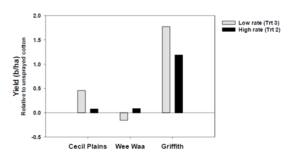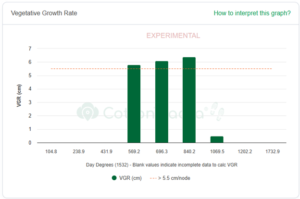Key takeaways
|
At this time of year, many would be considering managing vegetative growth of their cotton crop. Mepiquat chloride is an anti-gibberellin growth regulant used to manage excessive vegetative growth of cotton crops.
Research led by Katie Broughton of CSIRO last season was supported by the CRDC and with CSD. The CSD component of the project was made possible through the Richard Williams Initiative.
Many in the industry have witnessed both positive and negative impacts associated with its use. This project, supported by growers and consultants, aids them in building a better understanding of mepiquat, and how it can be utilised leading to improvements in crop productivity and performance.
The project was hosted on four farms to understand the effects of various alternative early season mepiquat chloride application strategies on cotton growth and yield (see Table 1). Application timings varied from early squaring to mid flowering, depending on individual locations.
Table 1: Experiment details for grower/consultant supported investigations of early use of mepiquat chloride.
| Experiment Location | Treatments | Rate RX380TM |
| Cecil Plains Qld | 1. Control
2. High Rate Early 3. Grower Rate |
None
60 ml/ha (at early flowering) 120 ml/ha (at cut-out) |
| Wee Waa NSW | 1. Control
2. High Split Application 3. Low Split Application |
None
60 ml/ha applied 3 times* 25 ml/ha applied 3 times* |
| Aberdeen NSW
|
1. Control
2. High Split Application (Includes comparison of varieties Sicot 606B3F and Sicot 748B3F |
None
60 ml/ha applied 2 times (at early flowering and mid flowering) |
| Griffith NSW | 1. Control
2. High Split Application 3. Low Split Application |
None
60 ml/ha then 2 times at 100 ml/ha* 25 ml/ha then 60 ml/ha then 100ml/ha* |
*application times for these treatments were at first square, early flowering, and mid flowering
Key research questions raised by our co-operating growers and consultants included:
- How early and “hard” should we apply mepiquat chloride?
- Is there a difference in varieties and how we should use mepiquat chloride?
Firstly, why apply mepiquat chloride?
Cotton is a perennial plant and has an inbuilt tendency for vegetative growth to dominate over the reproductive growth phase. The use of mepiquat chloride can assist with improving the ratio of reproductive to vegetative growth at and/or during early flowering, especially in very favourable growing conditions.
However, unnecessary or excessive use of the product can be detrimental to final yield.
How early and hard should mepiquat be applied?
Although there were no statistically significant differences in yield between mepiquat chloride treatments across all sites there were tendencies for yield to be improved in the more southern growing regions with mepiquat chloride applied early. The relative yield (the yield difference between the control and the mepiquat treatment) was up to a bale more with applied mepiquat chloride compared to the control (see Figure 1). Little differences were recorded in Wee Waa and Cecil Plains.
Utilising mepiquat chloride as a tool, however, is not a quick fix – it was evident that a good understanding of the implications of the chemical is essential. At the Griffith site, there were more gains in relative yield with a low rate compared with a high rate of mepiquat chloride.

Figure 1: Relative yield (bales/ha) of cotton applied with two alternative mepiquat chloride strategies across three locations spanning the Australian cotton industry. Note that differences were not significant (P>0.05).
Is there a difference in varieties and how we should use mepiquat chloride?
The project site at Aberdeen compared early applications of high rates of mepiquat chloride on Sicot 748B3F and Sicot 606B3F. There was no significant difference determining a specific early season mepiquat chloride strategy for those two varieties (results not shown). This emphasises that decisions for mepiquat application should be based on in-crop measurements and utilising the Australian Cotton Production manual, rather than variety alone.
Further research will continue to explore the use of mepiquat chloride, particularly managing crop growth to enhance resource use efficiency in a farming systems context.

Katie Broughton, CSIRO, presenting at a field day in the 2023/24 season.
Want to know more?
You can catch Katie’s presentation on mepiquat chloride use and a summary of her project, as she presented to CSD’s Mastering Cotton Forum in August this year. https://csd.net.au/blogs/catch-up-on-the-2024-csd-mastering-cotton-forum/
Utilise the Australian Cotton Production Manual, 2024 and read more in Chapter 15. Australian Cotton Production Manual 2024 | CRDC
CSD’s CottonTracka™ helping better manage the crop canopy
Tracking your crop growth can help understand whether your crop is reaching its potential. By monitoring your crop’s node and height development compared to potential rates of crop development, you can identify if there is an imbalance in the vegetative growth rates (VGR), and this information can be used to understand if management interventions with MC are needed.
CottonTracka™ has been recently upgraded and includes a section to aid you tracking VGR. The tool monitors vegetative growth, emphasising its ability to account for both development rate and growth rate.

Figure 2: an example of VGR displayed in CSD’s CottonTracka™.
To access CottonTracka™, visit csd.net.au/trackwithcottontracka.